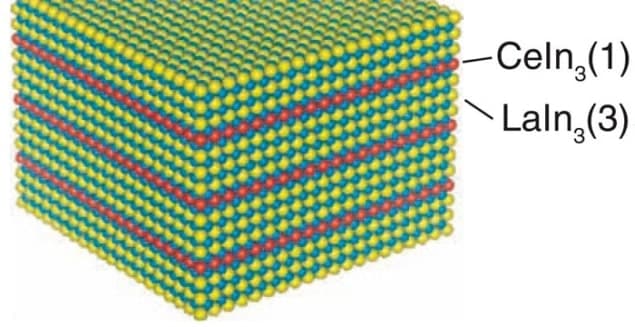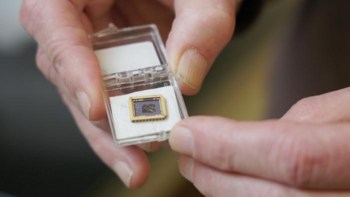
Physicists in Japan have created the first 2D “heavy-fermion” material – providing the best evidence yet that heavy fermions undergo a quantum phase transition. The material was made using molecular beam epitaxy (MBE), which also allowed the researchers to carry out the first systematic study of how the electronic properties of a heavy-fermion material change when it is made into layers just one molecule thick. The results could help physicists to understand why some other layered materials superconduct at relatively high temperatures.
Heavy-fermion materials such as cerium indide (CeIn3) are so called because their conduction electrons, which are fermions, move as if they are hundreds of times more massive than electrons in conventional metals such as copper. This large “effective mass” arises because the interactions between the electrons are very strong. Similar strong interactions are thought to play an important role in high-temperature superconductors – a class of materials that physicists have struggled to understand for nearly 25 years.
Heavy-fermion materials therefore provide a useful testbed for high-temperature superconductors. Even better, a wide range of heavy-fermion materials with slightly different electronic properties can be made by combining metals such as indium or aluminium with rare-Earth elements like cerium. High-temperature superconductors cannot be easily altered in such systematic ways.
Layered structures
Physicists are particularly keen to understand how heavy fermions behave in materials with layered crystal structures because high-temperature superconductors are also made from 2D layers. In particular, layered heavy-fermion materials would let them test the idea that high-temperature superconductivity is linked to the electrons being confined to 2D crystalline planes.
That link is backed up by the observation that some superconductors exist in states near to a quantum phase transition. Unlike conventional phase transitions, which occur at finite temperatures and are driven by thermal fluctuations, quantum phase transitions occur at absolute zero and are driven by quantum fluctuations, which are more persistent in 2D materials.
Unfortunately, while physicists have had some success in growing 3D heavy-fermion crystals, they had struggled to find materials that contain the desired 2D confinement. Now, however, Yuji Matsuda and colleagues at the University of Kyoto and Nagoya University have borrowed a technique from the semiconductor industry to create the first layered heavy-fermion materials.
Matsuda’s team used molecular beam expitaxy (MBE) to deposit 30 alternating layers of CeIn3 and lanthanum indide (LaIn3) on an atomically flat substrate. LaIn3 is used because it has a similar crystal structure to CeIn3, but is not a heavy-fermion material. The team made several different structures this way – all with LaIn3 layers four molecules thick – but with CeIn3 layers that varied from one to eight molecules thick.
2D versus 3D
The LaIn3 layers are thick enough that there should be no coupling between electrons in adjacent layers – which means that each CeIn3 layer should behave as a separate and isolated system. Furthermore, the one-molecule-thick layers should behave as a 2D material, whereas the eight-molecule-thick layers should exhibit 3D behaviour.
The team looked for evidence of a quantum phase transition as the CeIn3 layers became thinner. Although it is impossible to cool a sample to absolute zero, Matsuda and colleagues were able to chill their structures to 100 mK. They found two tantalizing bits of evidence pointing to a quantum phase transition between magnetic and non-magnetic phases of CeIn3.
First, the resistivity of the material was found to increase when exposed to a magnetic field. Second, the resistivity of the material shifted from being a quadratic function of temperature for thick CeIn3 layers to a linear function of temperature for the thinnest layers. Both of these suggest that electrons are scattering from quantum magnetic fluctuations in the CeIn3 layers.
Missing superconductivity
“This study has shown that a quantum critical point occurs in this heavy-fermion material,” says Suchitra Sebastian of the University of Cambridge in the UK. However, she points out that superconductivity was not seen in this system – something that she hopes will be seen in future MBE experiments.
Instead, the resistance of the thin layers is very large, which Matsuda and colleagues believe is related to the diffusion of lanthanum (La) atoms into the CeIn3 layers. These impurities would scatter the electron pairs needed for superconductivity. This problem could be alleviated by using a spacing material other than LaIn3.
The study is described in Science 327 980.



